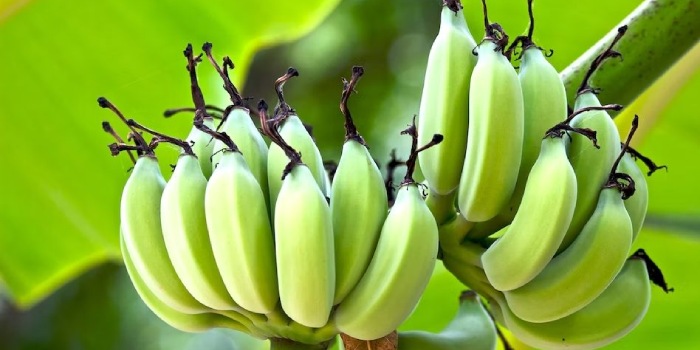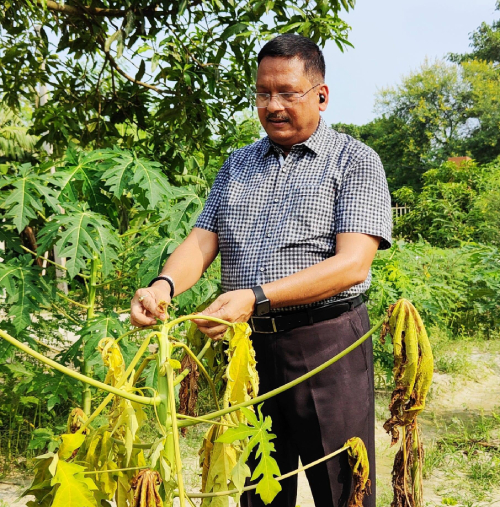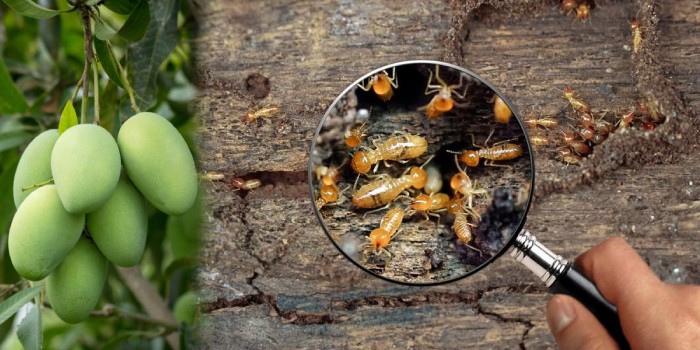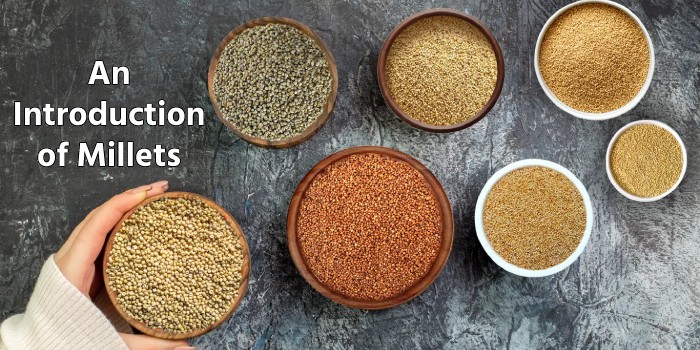
Guru Dayal
Project Assistant – DBT Turmeric Project,
Department of Soil Science & Agricultural Chemistry,
Institute of Agricultural Sciences,
Bundelkhand University, Jhansi, U.P.
Raghvendra Kumar Kushwaha
PG Scholar - M.Sc. (Agri.) Soil Science
Sam Higginbottom University of Agriculture,
Technology and Sciences, Allahabad-211007,U.P.
Introduction of Millets-
Small- seeded millet, which belongs to the gramineae and poaceae families, is used worldwide for food and fodder. They have a rounded form. India is the largest producer country in the world, contributing 20% of the total production in 131 countries across the world. Per 100 gram of millet, there are a lot of calories (378 kcal), carbohydrate (65-75%), fat (2-5%) and proteins (7-12%). A member of the grass family, millet is a small grain crop grown annually in temperate, tropical, subtropical and dry regions. It can also be grown on marginal lands. It is frequently raised as a catch crop. Nutritious cereals, also known as nutritious cereals, contribute significantly to food and nutritional security. Nutrient cereal crops perform well in marginal environment and have superior nutritional properties with high micronutrient content and low rheological index. These have unique nutritional properties, especially the abundance of digestive fibers, carbohydrates, as well as nutritious medicinal properties, phenolic compounds and phytochemicals are also found. Nutritious cereals are natural sources of iron, zinc, calcium and other nutrients necessary to overcome the problem of malnutrition in India.
The millets were grown. In addition to this, the Indus civilization in India contains traces of it. When millets are produced as food and fodder, they are primarily grown in Rajasthan, Karnataka, Maharashtra and Haryana in India. It is also known as Cheenaka or kangus in Sanskrit, in India. The steps taken by the Government of India have had a positive effect, in which the production of nutritious grains which was 164 lakh tonnes in the year 2017-18 has increased to 176 lakh tonnes in the year 2020-21. The productivity of nutritious cereals was 1163 kg/ha in the year 2017-18, which has increased to 1239 kg/ha in the year 2020-21. The export of Nutritious Cereals or Millets was equivalent to US$ 21.98 million in the year 2017, which has increased to US$ 24.73 million equivalent in the year 2020 (Source - Kheti).
Taxonomical classification of Millets –
- Kingdom : - Plantae
- Subkingdom : - Tracheobionta
- Superdivison : - Spermatophyta
- Division : - Magnoliophyta
- Class : - Liliopsida
- Subclass : - Commelinidae
- Order : - Cyperales
- Family : - Poaceae
- Genus : - Pennisetum
- Species : - glaucum.
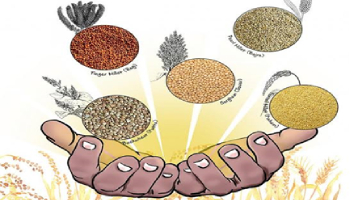
Fig- Different types of millets
The following three kinds of millet are the basic divisions based on human utility.
1. Major millets
2. Minor millets
3. Pseudo millets
1. Major millets- It is divided in to three main parts.
a) Pearl millets
b) Finger millets
c) Sorghum
a) Pearl millets- Pearl millets are frequently grown in the African continent and it is a food and fodder source in India.
| Scientific Name | Nutrients (per 100g) | Use |
| Pennisetum glaucum | Kcal- 378,Protein- 10.6,Fat- 4.8, Fiber- 1.3 ,Iron- 16.9, Carbohydrates- 67.5 | Diabetes patients, Cancer patients, Heart patients. |
b) Finger millets- In India, finger millet is referred to as ragi and it is a pollen-rich crop it belongs to the poaceae plant family. Chromosome diploid 2n=16 are found in this short-day plant and a temperature range of 18-27 degrees is thought to be ideal for healthy growth and development.
| Scientific Name | Nutrients (per 100g) | Use |
| Eleusine coracana | Kcal- 336,Protein- 7.3,Fat- 1.5, Fiber- 3.6, Iron- 3.9, Carbohydrates- 72.0 | Makes bone strong, Blood pressure, Liver disorders, Heart patients. |
c) Sorghum- Sorghum is a 2n=2x=20 and 25-30 degree diploid. The temperature is thought to be ideal for its development and growth. It is also referred to as giant millet, broomcorn, and guinea corn in India. And for this, a pH of 5.5 to 8.5 is regarded as acceptable.
| Scientific Name | Nutrients (per 100g) | Use |
| Sorghum bicolor | Kcal- 329,Protein- 10.4 Fat- 3.1,Fiber- 2.0, Iron- 5.4, Carbohydrates- 72.0 | Nerve cell development, heart health, metabolism, blood sugar levels and lower cholesterol. |
2. Minor millets – In India, this category includes the top five crop. These the majority of crop are grass or poaceae family members.
(a) Foxtail millet (b) Koda millet (c) Proso millet (d) Little millet (e) Barnyard millet
a) Foxtail millet- Foxtail millet is a complete crop of grass. Additionally, 266to 29 degrees Fahrenheit is thought to be ideal for its growth and tropical temperatures are ideal for its easy growth. The pH value of 5.5 to 7 is said to be ideal foe this crop, which is primarily farmed in the kharif season.
| Scientific Name | Nutrients (per 100g) | Use |
| Setaria italica | Kcal- 473,Protein- 12.3,Fat- 4.0,Fiber- 8 Iron- 2.8,Carbohydrates- 60.9 | Nervous system patients, Diabetes patients. |
b) Koda millet- Which has 2n=2x=14 chromosomes and prefers loamy soil for cultivated. The ideal temperature for the plant is thought to be between 26 to 29 degrees. Which has 2n=2x=14 chromosomes and prefers loamy soil for cultivated. The ideal temperature for the plant is thought to be between 26 to 29 degrees.
| Scientific Name | Nutrients (per 100g) | Use |
| Paspalum scrobiculatum | Kcal- 309,Protein- 8.3,Fat- 3.6,Fiber- 9.0, Iron- 2.8,Carbohydrates- 66.6 | Diabetes patients. |
c) Proso millet- Which is planted in kharif and is adapted to hot climates. These plant, which have a pH range of 5.5 to 6.5, are C4 plant.
| Scientific Name | Nutrients (per 100g) | Use |
| Panicum miliaceum | Kcal- 356,Protein- 12.5,Fat- 2.9,Fiber- 2.2,Iron- 0.8,Carbohydrates- 70.4 | Pellagra patients, Diabetes patients, Cholesterol patients |
d) Little millet – The entire harvest of this grass. Which is a crop grown in tropical and subtropical climate and is frequently referred to by the name shavan and kuril.
| Scientific Name | Nutrients (per 100g) | Use |
| Panicum sumatrense | Kcal- 207,Protein- 7.7,Fat- 5.2,Fiber- 7.6 Iron- 9.3,Carbohydrates- 64.87 |
Diabetes, reduce cholesterol. |
e) Barnyard millet- Commonly referred to as savat rice, is thought to grow best in temperatures between18 to 27degree. In a warm and humid climate, it is easily cultivated
| Scientific Name | Nutrients (per 100g) | Use |
| Echinochloa esculenta | Kcal- 342,Protein- 11.2,Fat- 3.9,Fiber- 10.1,Iron- 15.2,Carbohydrates- 68.8 | Heart patients, Diabetes patients, Blood pressure. |
3. Pseudo millets – Pseudo millets are primarily grass crop. It is split into the two sections listed below.
a) Buckwheat b) Amaranth
a) Buckwheat- Scientifically known as Fagopyrum esculentum, has a high content of calories (77%), proteins (3g), fat(1g) and carbohydrates (20g). It is used to treat heart disease, excessive cholesterol and varicose veins.
b) Amaranth- Scientifically known as Amaranthus L. , this grain is consumed as food and seed oil. These are frequently grass family members and include 23 kcal of energy,2.46 gram of protein and 0 gram of carbohydrate.
Health Benefits:-
- They generally have the potential to fight the problem of acidity in human.
- Along with these properties it helps in reducing the BP related problems, curing two types of diabetes, risks of gastrointestinal conditions or colon cancer, bloating etc.
- They are gluten free and hence they are a good option to consider for gluten sensitivity.
- They are easy to digest so they are suitable for every aged person.



